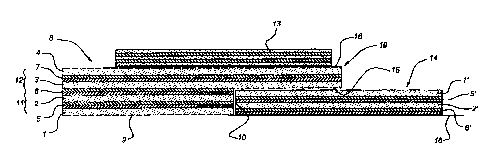Some of the information on this Web page has been provided by external sources. The Government of Canada is not responsible for the accuracy, reliability or currency of the information supplied by external sources. Users wishing to rely upon this information should consult directly with the source of the information. Content provided by external sources is not subject to official languages, privacy and accessibility requirements.
Any discrepancies in the text and image of the Claims and Abstract are due to differing posting times. Text of the Claims and Abstract are posted:
| (12) Patent Application: | (11) CA 2476785 |
|---|---|
| (54) English Title: | METHOD FOR FORMING A LAMINATE WITH A REBATE |
| (54) French Title: | METHODE DE FORMAGE D'UN MATERIAU STRATIFIE AVEC FEUILLURE |
| Status: | Deemed Abandoned and Beyond the Period of Reinstatement - Pending Response to Notice of Disregarded Communication |
| (51) International Patent Classification (IPC): |
|
|---|---|
| (72) Inventors : |
|
| (73) Owners : |
|
| (71) Applicants : |
|
| (74) Agent: | SMART & BIGGAR LP |
| (74) Associate agent: | |
| (45) Issued: | |
| (22) Filed Date: | 2004-08-06 |
| (41) Open to Public Inspection: | 2005-02-08 |
| Examination requested: | 2009-07-13 |
| Availability of licence: | N/A |
| Dedicated to the Public: | N/A |
| (25) Language of filing: | English |
| Patent Cooperation Treaty (PCT): | No |
|---|
| (30) Application Priority Data: | ||||||
|---|---|---|---|---|---|---|
|
A method for the production of a laminate consisting of metal layers as well
as at
least one fibre-reinforced bonding layer (5 - 7) that is located between the
metal layers (1
- 4), which laminate has at least one region (9) that has a smaller number (3,
4, 7) of layers
than the remainder of the laminate, comprises the following step:
- forming a stack (8) consisting of metal layers (1 - 4) and at least one
fibre layer
(5 - 7) impregnated with a binder, which stack (8) has a first series (11) of
successive layers
(1, 2, 5, 6) with a different surface size to a second series (12) of
successive layers (3, 4, 7),
such that one (12) of the series of layers protrudes with respect to the other
series (11) of
layers,
- placing an auxiliary tool (14) at the protruding portion (19) of the
protruding series
(12) of layers alongside the other series (11) of layers, which auxiliary tool
(14) has a
make-up that is the same as that of said other series (11) of layers.
- activating the fibre-reinforced bonding layers (5, 6, 7) under elevated
pressure and
temperature with the formation of the laminate.
Note: Claims are shown in the official language in which they were submitted.
Note: Descriptions are shown in the official language in which they were submitted.

2024-08-01:As part of the Next Generation Patents (NGP) transition, the Canadian Patents Database (CPD) now contains a more detailed Event History, which replicates the Event Log of our new back-office solution.
Please note that "Inactive:" events refers to events no longer in use in our new back-office solution.
For a clearer understanding of the status of the application/patent presented on this page, the site Disclaimer , as well as the definitions for Patent , Event History , Maintenance Fee and Payment History should be consulted.
| Description | Date |
|---|---|
| Application Not Reinstated by Deadline | 2011-08-08 |
| Time Limit for Reversal Expired | 2011-08-08 |
| Inactive: IPC deactivated | 2011-07-29 |
| Deemed Abandoned - Failure to Respond to Maintenance Fee Notice | 2010-08-06 |
| Letter Sent | 2009-08-26 |
| All Requirements for Examination Determined Compliant | 2009-07-13 |
| Request for Examination Requirements Determined Compliant | 2009-07-13 |
| Request for Examination Received | 2009-07-13 |
| Inactive: IPC from MCD | 2006-03-12 |
| Inactive: IPC from MCD | 2006-03-12 |
| Inactive: IPC from MCD | 2006-03-12 |
| Inactive: IPC from MCD | 2006-03-12 |
| Inactive: First IPC derived | 2006-03-12 |
| Application Published (Open to Public Inspection) | 2005-02-08 |
| Inactive: Cover page published | 2005-02-07 |
| Letter Sent | 2004-11-18 |
| Inactive: Single transfer | 2004-10-19 |
| Inactive: First IPC assigned | 2004-10-17 |
| Inactive: IPC assigned | 2004-10-17 |
| Inactive: IPC assigned | 2004-10-17 |
| Inactive: Courtesy letter - Evidence | 2004-09-21 |
| Inactive: Filing certificate - No RFE (English) | 2004-09-16 |
| Filing Requirements Determined Compliant | 2004-09-16 |
| Application Received - Regular National | 2004-09-16 |
| Abandonment Date | Reason | Reinstatement Date |
|---|---|---|
| 2010-08-06 |
The last payment was received on 2009-07-30
Note : If the full payment has not been received on or before the date indicated, a further fee may be required which may be one of the following
Please refer to the CIPO Patent Fees web page to see all current fee amounts.
| Fee Type | Anniversary Year | Due Date | Paid Date |
|---|---|---|---|
| Application fee - standard | 2004-08-06 | ||
| Registration of a document | 2004-10-19 | ||
| MF (application, 2nd anniv.) - standard | 02 | 2006-08-07 | 2006-07-25 |
| MF (application, 3rd anniv.) - standard | 03 | 2007-08-06 | 2007-07-19 |
| MF (application, 4th anniv.) - standard | 04 | 2008-08-06 | 2008-07-16 |
| Request for examination - standard | 2009-07-13 | ||
| MF (application, 5th anniv.) - standard | 05 | 2009-08-06 | 2009-07-30 |
Note: Records showing the ownership history in alphabetical order.
| Current Owners on Record |
|---|
| STORK FOKKER AESP B.V. |
| Past Owners on Record |
|---|
| ABDOEL FAZIEL RAJABALI |